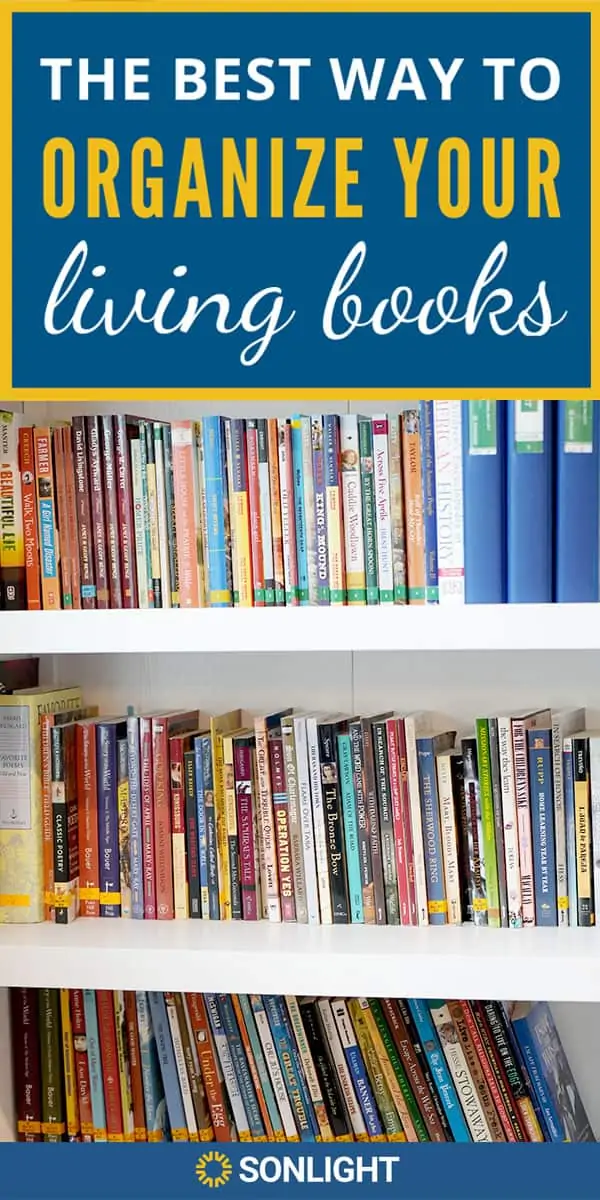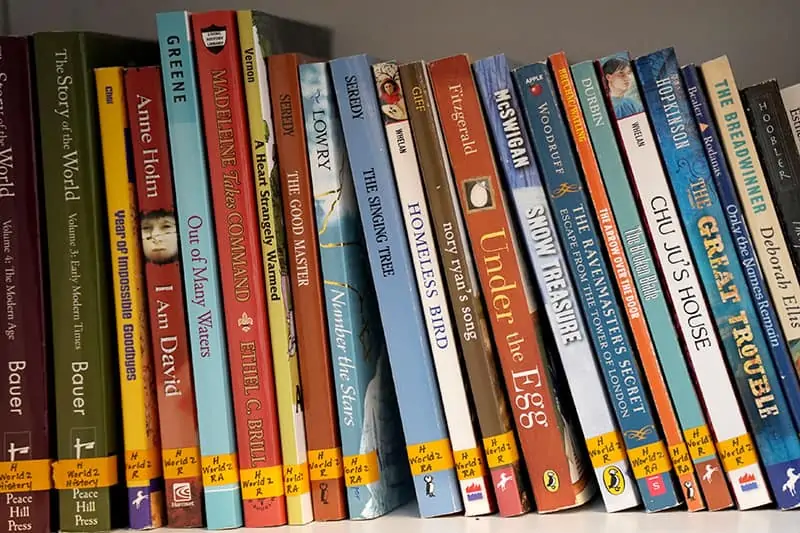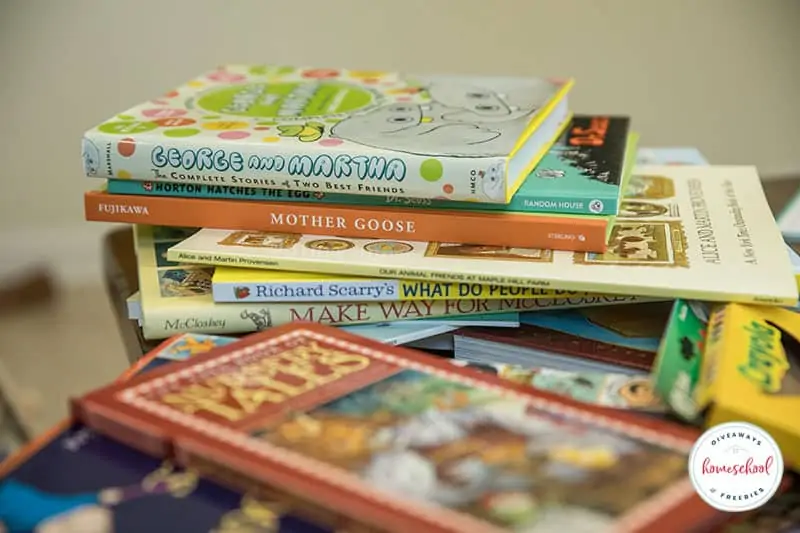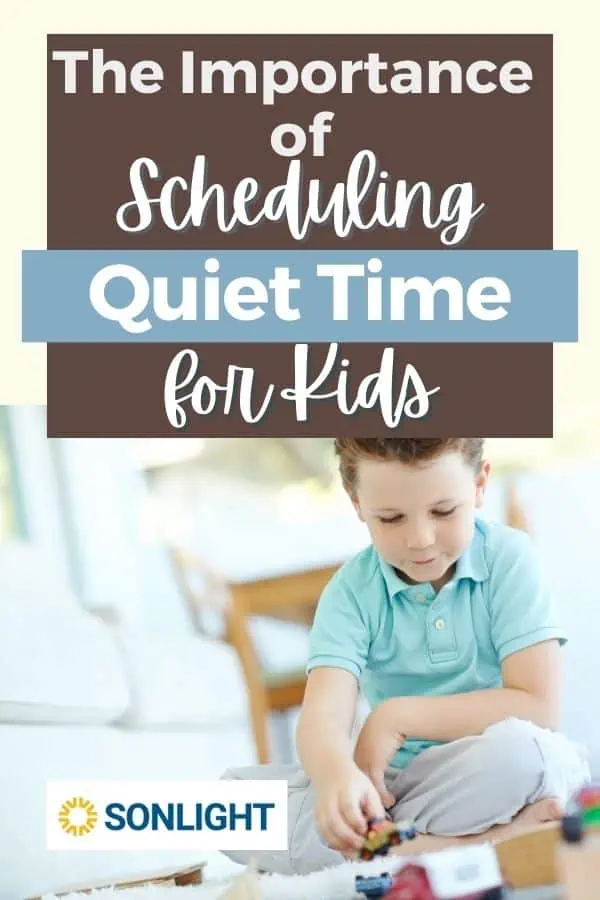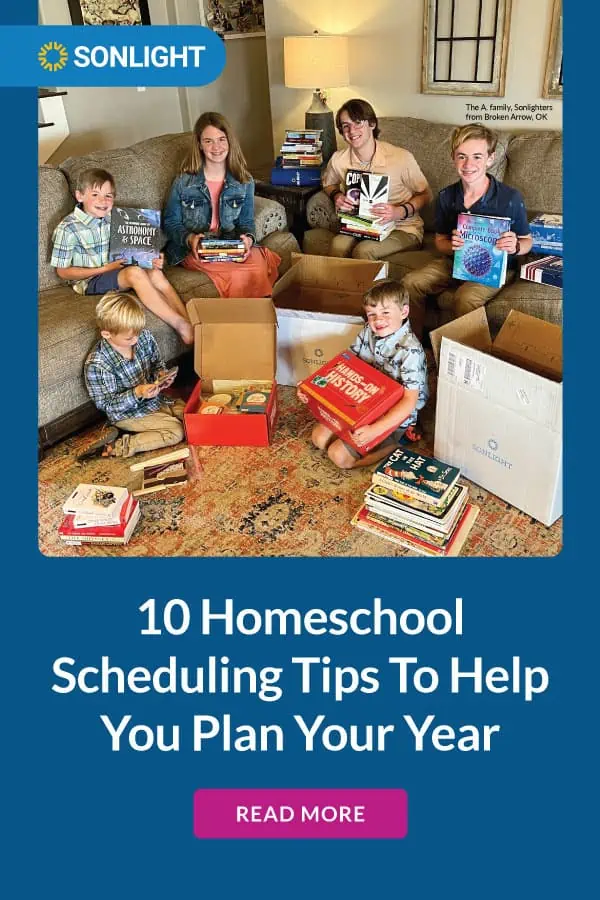The Best Way to Organize Your Living Books
Published:
January 13, 2022

Contributor:
Sonlight
Disclosure: This post may contain affiliate links, meaning if you decide to make a purchase via my links, I may earn a commission at no additional cost to you. See my disclosure for more info.
When you homeschool using living books, it won’t take long to realize that organizing your school books is essential. Here are practical solutions for organizing your homeschool library.
Home Library
If you have a lot of books, you might think you need a dedicated floor to ceiling bookshelf or a homeschool room. But you don’t. Making use of the space you have for organizing books is key. This may be easier said than done, and the best place to start is by decluttering what you no longer need or use.
Now, Marie Kondo would suggest that you need to pull every single book off your shelf and decide if it sparks joy. The better solution for homeschool moms is to have a vision for your homeschool, decide what you will need going forward and where you will store it. In the end, you simply need an inviting and comfortable place to learn together.
Determine Where You Can Store Your Living Books
In order to eliminate book clutter and random piles of books from your space, first determine where you will store the books you regularly use. Again, this doesn’t have to be in fancy bookshelves. Use the space and furniture that you have. Maybe you have a dining room hutch that would better serve your homeschooling needs as a home library because you homeschool at the table. Then use that! Maybe your kids have bookshelves in their bedrooms and it makes sense for your older kids to keep their books in their own space. Check out these 5 additional tips for organizing your homeschool in small spaces for ideas.
Finding Space
Whatever it is, use what you have. Then, if you still need more space or furniture for holding your large collection of living books, see if you can find furniture at your local thrift store or online marketplace.
You might only have a mini library in your home at any one time. If you know which children’s books will be needed this year in your homeschool, you might be able to store books until another child needs them in a coming year.
The bottom line here is that you don’t need a full-fledged wall of bookshelves to have a very usable homeschool library of living books. You just need to find the best way for your family to organize them. Here are a few points to consider as you organize your books.
Accessibility
You will have a hard time using your books if they are not accessible. Approach your book organization by asking where and when you will use the books. There are a number of ways to organize your homeschool library. Here are five ideas to consider.
1. Organize By Topic
Book and binder labels are a great option for organizing homeschool books by topic or level. Keep your history books clearly marked from your science books with labels on the book covers for general categories. Sonlight’s book labels help to clearly identify the books for any given History / Bible / Literature or Science program.
You may even create your own labeling system, like you see in the photo below. You’ll notice that these Sonlight Readers are labeled with the level “H” and “World 2” for Sonlight Level H, World History (Year 2 of 2). The “R” stands for Reader and the “RA” for Read-Aloud. When using living books curriculum from Sonlight with multiple children, a labeling system makes it easy to stay organized and locate books from multiple programs easily.
For your younger kids, find a bin that can hold their board books. No need to be fancy here with toddler book organization. Using a bin that you can easily pull off the shelf will help you to keep those books convenient for reading on the couch or taking them along in the car. Storing board books on the bottom shelf provides easy access to books and allows young children to access their board books independently.
2. Organize By Family Member
When multiple children have a pile of books this year for their reading lists, then maybe you can give each child their own shelf space. That way, they can visually keep track of their reading goals for the year and how they are progressing. Keeping their own books organized is an easy way to delegate responsibility to your kids.
3. Organize By Title or Author
Of course, you can also organize your living books using the Dewey Decimal System or by book title or author’s last name. Some homeschool families find this laborious, but you just might spark some interest in one of your children who would like to take this project on themselves to keep the family books organized in this way.
The Dewey Decimal System organizes mostly nonfiction by subject, then author’s last name. Here are the general topics that the system uses. Even if you don’t go all-in with labeling and cataloguing your books this way, you can still use the general categories for inspiration.
Category Inspiration from Dewey Decimal System
- 000 – Computer science, information & general works
- 100 – Philosophy and Psychology
- 200 – Religion
- 300 – Social Sciences
- 400 – Language
- 500 – Natural Sciences
- 600 – Applied Sciences and Technology
- 700 – Arts and Recreation
- 800 – Literature
- 900 – History, Geography, and Biography
4. Organize by Genre
For all your fiction books, consider organizing by genre. This just means organizing your books almost like a bookstore. Books are easier to find when loosely organized by category and subject. Organizing by genre allows you to put your books into categories that make sense for your homeschool. It’s very flexible.
One genre might be your preschooler’s picture books. Consider finding a way to display your preschooler’s books with the cover facing out providing an easy way to find their favorites.
Another tip for organizing your living books is to mix in horizontal stacks with vertical placement. Sometimes large books just don’t fit upright on a standard-sized bookshelf. But you can still have a cohesive and usable organization method by interspersing some horizontal stacks.
5. Organize by Frequency of Use
Homeschool families know that some books are used all the time. Others are used sporadically or once a year. So when you’re considering how to organize your books, consider the frequency of use.
One rule of thumb: books that aren’t used as often can inhabit a top bookshelf. The books you need regularly should be within easy reach. Another key to organizing by frequency of use is to store your homeschool books close to where you will use them. There is nothing worse than not having books and materials where you need them. Another tool to consider is a rolling metal cart. There are some sturdy ones on the market and they would provide a great way to keep your most-used books handy.
Strewing
Homeschool families know the benefits of strewing. By keeping a stack of books on the coffee table, your children are likely to pick them up out of curiosity and dive in. You can choose a particular book based on your current studies or find picture books by your favorite authors. However you decide to do it, having easy access to living books is the first step to encouraging a lifelong love of learning.
Another option for stewing is to just include new books in your careful placement around the house. Kids love flipping through new-to-them books.
You Do You
The best advice for almost any homeschooling topic is to do what fits your family best. Consider having a family meeting (if your children are old enough to participate) and discuss how your homeschool classroom library should be organized. The best thing is to get input from those that will be using the books in the first place. Then you can also talk through how the whole family will work together to keep the space organized.
Take a hint from the way a professional organizer works. They get input from the client. They figure out the personal preference of each family they work with and then they set up a system. But when they’re done organizing, professional organizers always discuss the system with the client. That way, the next time things are out of place, the client is able to easily put things away.
Keeping Books Organized is a Team Effort
An important part of homeschooling is creating a team effort in everything you do, including organizing your books. So work with your kids, train your kids, and then cheer them on as they help you keep an orderly space. This is a life skill worth investing in.
Stay Organized
The most important part of learning how you like to organize books is to stay organized. You can find a great system, but unless you teach your kids how the system works and how to reshelve books, you’ll find yourself in a never-ending spiral of playing librarian!
One tip to help your children with the reshelving process: give your kids a paint stirrer from the hardware store and paint their favorite color on one end. When they take a book from the shelf, have them grab the paint stirrer. Use it to keep track of where the book should go when they’re done with it. This is an easy way to enlist the help of your family members for staying organized.

